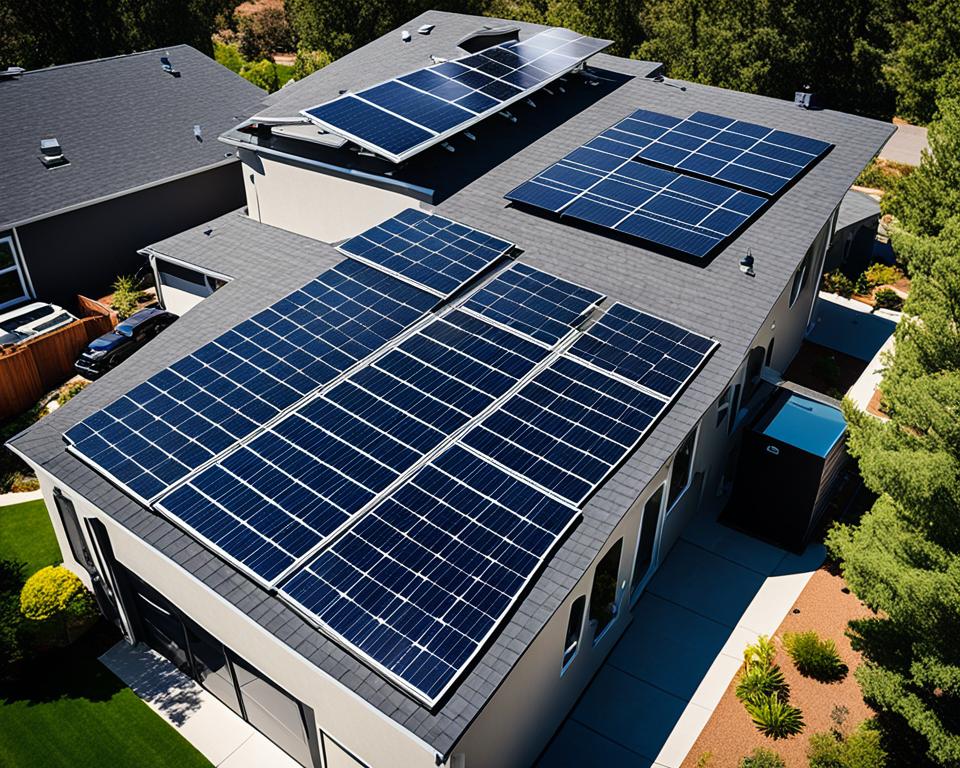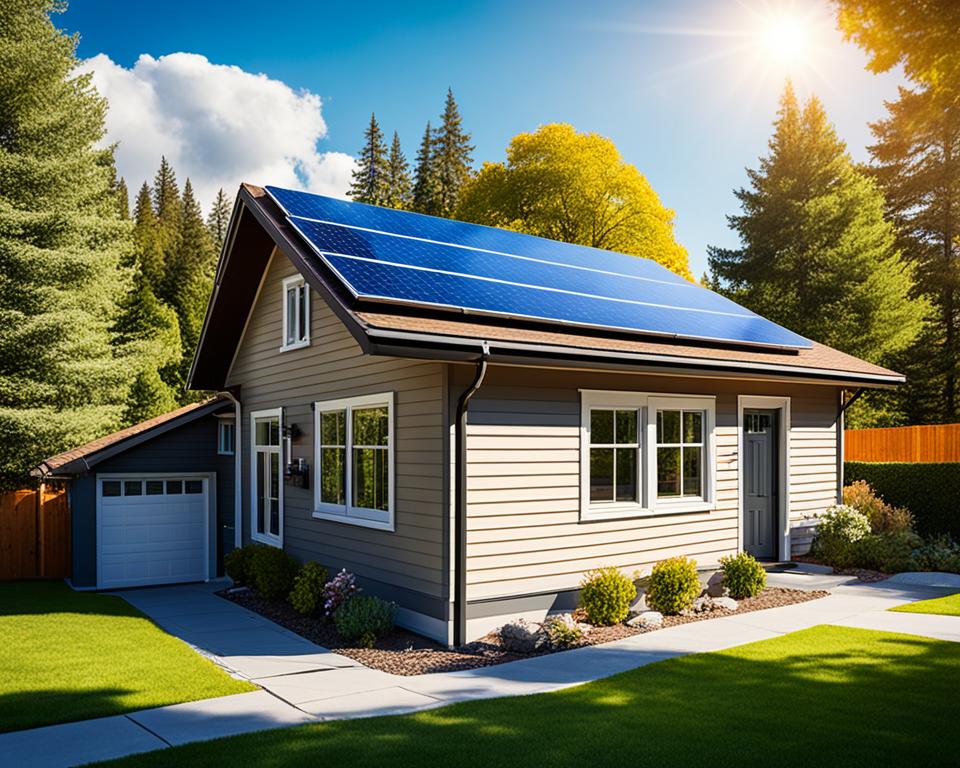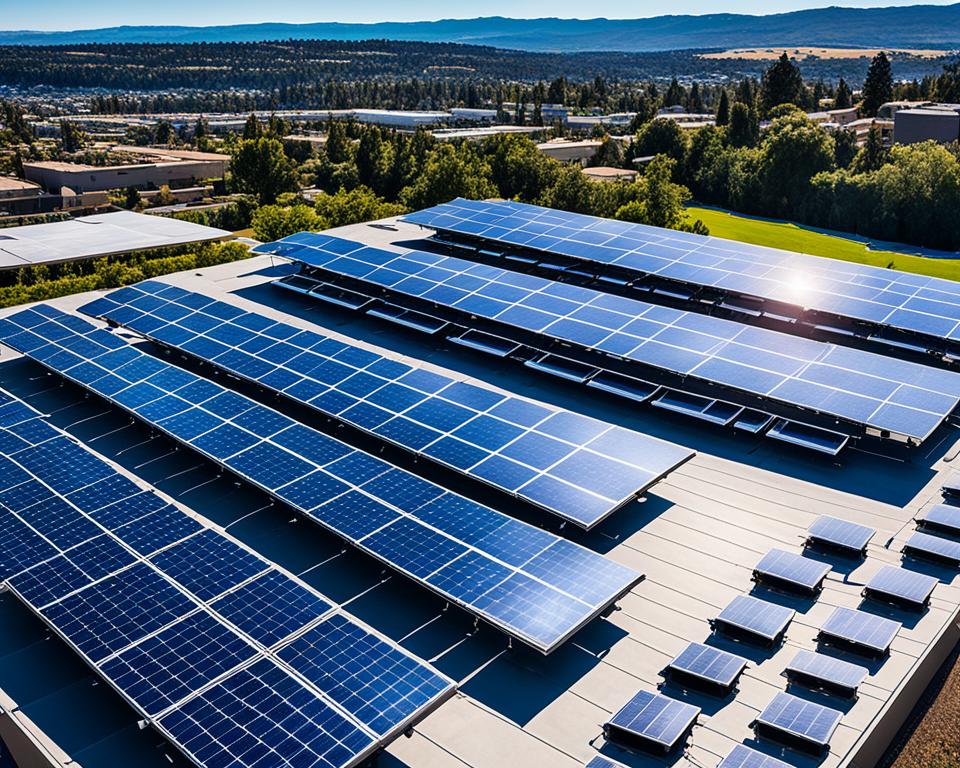A full solar panel system captures the sun’s power to create renewable energy. It includes solar panels, an inverter, and energy storage batteries. This setup helps you turn sunlight into electricity, cutting the need for fossil fuels. By using this system, you lower your power bills and help the planet live more sustainably.
Read interesting things at : vsocan
Key Takeaways
- A full solar panel system is a comprehensive solution to generate renewable energy from the sun.
- It includes solar panels, an inverter, and energy storage batteries to power your home or business.
- Investing in a full solar panel system can lead to long-term cost savings on your energy bills.
- Installing a full solar panel system helps reduce your carbon footprint and contributes to sustainable living.
- The system allows you to efficiently convert sunlight into usable electricity, reducing your reliance on traditional fossil fuel-based power sources.
What Is a Full Solar Panel System?
A full solar panel system is a complete setup that includes several solar panels, an inverter, and batteries for energy storage. It also has other parts to turn sunlight into usable electricity. This setup lets homes and businesses use the sun’s power. They rely less on fossil fuel-based energy and more on renewable energy. This move supports a life that’s sustainable.
Components of a Solar Panel System
The key parts of a full solar panel system are:
- Solar Panels: These are the system’s core. They change sunlight into direct current (DC) electricity.
- Inverter: This part turns the DC power from the solar panels into alternating current (AC) electricity. It’s the type of power used in homes and businesses.
- Batteries: These batteries save extra electricity from the solar panels. This means you can use solar power even when the sun’s not out.
- Mounting Hardware: It includes everything needed to securely place the solar panels. They can be on a roof or on the ground.
- Electrical Components: These items are needed for safe and proper setup. They include wiring and circuit breakers, among other things.
Benefits of Going Solar
Getting a full solar panel system has many good points. It’s great for the planet and your budget. Some benefits are:
- Reduced Carbon Footprint: By using renewable energy from the sun, you rely less on fossil fuels. This cuts your carbon emissions, helping the earth.
- Long-Term Cost Savings: Though it costs a lot to set up a full solar panel system, you save big on energy bills over time. This makes it a smart investment.
- Increased Property Value: A solar panel system adds value to your property. It makes it more appealing to buyers now and in the future.
- Energy Independence: With solar, you depend less on the power grid. This gives you more power over how you use energy.
Assessing Your Energy Needs
Before you install a full solar panel system, you must look at how much energy you use. It’s important to know the right system size for your home. Think about your energy use and what might make your system bigger.
Calculating Your Household Energy Consumption
To find the right solar system size, figure out how much energy your home uses. Look at your past electricity bills to see how much energy you use each month and year. Knowing this helps you pick the perfect solar system. This can lower your electricity bill.
Factors Affecting Solar Panel System Size
Many things can change the size of the solar system you need. This includes how big your house is, the number of people living there, and your energy use. The climate and how much sun your house gets matter too. Shading or things in the way can also affect your solar system’s efficiency.
Thinking about all these things will help you get the right size system for your energy needs.
Choosing the Right Solar Panels
Choosing the right solar panels is key for your system. You should think about the types of solar panels out there. Monocrystalline and polycrystalline are the main types.
Monocrystalline vs. Polycrystalline Solar Panels
Monocrystalline panels are very efficient, from 15% to 22%. They have a single crystal of silicon, which is very good at turning sunlight into power. Polycrystalline panels have several silicon crystals, making them a bit less efficient at 13% to 16%. But, they are cheaper for those on a budget.
Panel Efficiency and Wattage Ratings
Panel efficiency and wattage ratings are important. Efficiency shows how well a panel turns sunlight into electricity. Higher efficiency means more power from the same space. Wattage tells you how much power a panel can make. More watts mean your system can produce more energy.
| Feature | Monocrystalline Solar Panels | Polycrystalline Solar Panels |
|---|---|---|
| Efficiency | 15% – 22% | 13% – 16% |
| Wattage Ratings | 250W – 400W | 200W – 320W |
| Cost | Higher | Lower |
| Aesthetics | Uniform, sleek appearance | Slightly more textured appearance |
Think about what’s important when choosing between monocrystalline and polycrystalline solar panels. Look at their efficiency and wattage. This will help you pick the best solar panels for your needs.
Full Solar Panel System
A full solar panel system doesn’t only include solar panels. It also needs solar inverters and energy storage batteries.
Understanding Solar Inverters
The solar inverter is key in a full solar panel system. It turns direct current (DC) from the solar panels into usable alternating current (AC). This powers your home or business.
Choosing the right solar inverter is vital. Think about the size of your photovoltaic system and your power needs. The right inverter makes your full solar panel system more efficient and reliable.
Selecting Batteries for Energy Storage
Energy storage batteries are very important in a full solar panel system. They save extra solar energy for you to use later.
When picking batteries, look at their capacity and how long they last. You could go for lithium-ion or lead-acid. Each type has its pros and cons. Talking to a solar specialist will guide you in selecting the best batteries for your full solar panel system.

Site Evaluation and Panel Orientation
Your full solar panel system needs the right spot and direction to work well. You must check the site carefully to pick the best place and tilt angle for your solar panels. This will help them make the most energy possible.
Calculating Optimal Tilt Angle
The tilt angle is very important for your solar panels. It affects how well they catch the sun’s rays. Knowing the right tilt angle for your area means your full solar panel system can get more sunlight. This leads to more power being created.
Avoiding Shading and Obstructions
Thinking about shading and obstructions is key too. You want to place your solar panels where they won’t be shaded by trees or buildings. This makes them work better and produce more energy.
Grid-Tied vs. Off-Grid Solar Systems
When you’re setting up a full solar panel system, you’ll choose between grid-tied and off-grid. Each has its perks and things to think about.
Grid-Tied Solar Systems: Connected to the grid, these systems let you use grid power and send extra renewable energy back. You might get credit for this through net metering.
Off-Grid Solar Systems: These systems are stand-alone, perfect for far-off places or where the grid is iffy. You get a stable renewable energy supply without the grid.
| Feature | Grid-Tied Solar System | Off-Grid Solar System |
|---|---|---|
| Grid Connection | Connected to the electrical grid | Completely independent of the grid |
| Energy Storage | Relies on the grid for backup power | Requires batteries for energy storage |
| Net Metering | Eligible for net metering programs | Not eligible for net metering |
| Backup Power | Relies on the grid for backup power | Provides independent backup power |
| Initial Investment | Generally lower upfront cost | Requires investment in batteries and other off-grid components |
The choice between grid-tied and off-grid systems depends on what you need, where you are, and what you like. Both bring renewable energy benefits and fit different situations and budgets.

Permits and Incentives for Solar Installations
Before you get a solar panel system, understand your area’s permits and incentives. Getting the right permits and using tax credits and net metering can lower your costs. This makes switching to solar easier.
Federal and State Tax Credits
The U.S. government has the Solar Investment Tax Credit (ITC). It gives a big tax credit to those who install solar panels. Many states also have their own tax credits and rebates. This means more savings for solar panel buyers.
Net Metering Programs
Net metering lets solar panel owners get credit for extra electricity they provide. This can cut your energy costs or even earn you money. Net metering programs differ by state and energy company. Be sure to check what’s available where you live.
Solar Panel System Installation Process
There are two main ways to get a solar panel system: hire pros or do it yourself. Each way has benefits and things to think about for homeowners.
Hiring Professional Solar Installers
Hiring pros is best for an easy, stress-free set up. These skilled installers know how to plan, set up, and install your solar system right. They take care of everything, like getting permits and making sure your system works well. You also get a warranty and help with upkeep, which protects your investment.
DIY Solar Panel Installation
Some may choose to install panels themselves. This can save money for those who are good with technology and don’t mind the work. It lets you customize the system and learn more about it. But, you need to do your homework, get the right tools, and be ready for any hurdles you might face.
Maintaining Your Solar Panel System
To keep your full solar panel system running well, you must do regular checks and cleanings. Make sure to clean and inspect your system often. Also, track how well it’s working. These steps are key to keep your full solar panel system in top shape.
Regular Cleaning and Inspection
It’s vital to clean your solar panels for them to work their best. Dust and dirt can lower how much sunlight they can take in. Plan regular cleanings, whether you do it or call a professional for solar panel maintenance. This keeps your full solar panel system working efficiently.
Checking your full solar panel system regularly is also crucial. Look for damage, loose parts, or any issues that might lower your system’s performance monitoring. Solving these problems fast helps your full solar panel system last longer and stay efficient.
Monitoring System Performance
It’s a must to keep an eye on how your full solar panel system is doing. Get a good monitoring system or app. It’ll give you real-time details about your system’s energy, battery, and overall performance monitoring.
By watching your system closely, you can find and fix issues quickly. This ensures your full solar panel system stays in great condition.
Environmentally Friendly and Cost-Effective
Investing in solar panels is smart for our planet and your wallet. They use the sun’s energy, so you cut back on harmful emissions. This helps make the future more sustainable. Also, using solar power means you’re less reliant on polluting power sources.
Reducing Your Carbon Footprint
Solar panels at home mean you’re fighting climate change. They’re from a never-ending source, the sun. So, you cut your home’s pollution and live in a way that’s better for the Earth.
Long-Term Savings on Energy Bills
Solar panels don’t just help the planet; they save you money, too. With your own energy, you won’t pay as much to the power company. Eventually, the system pays for itself with lower bills. It’s a wise investment for families and companies.


